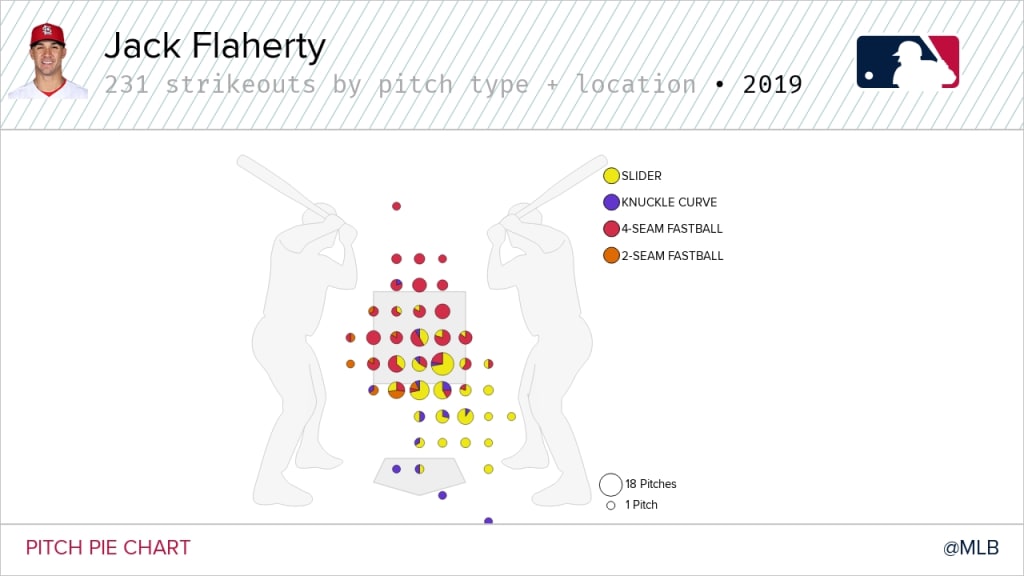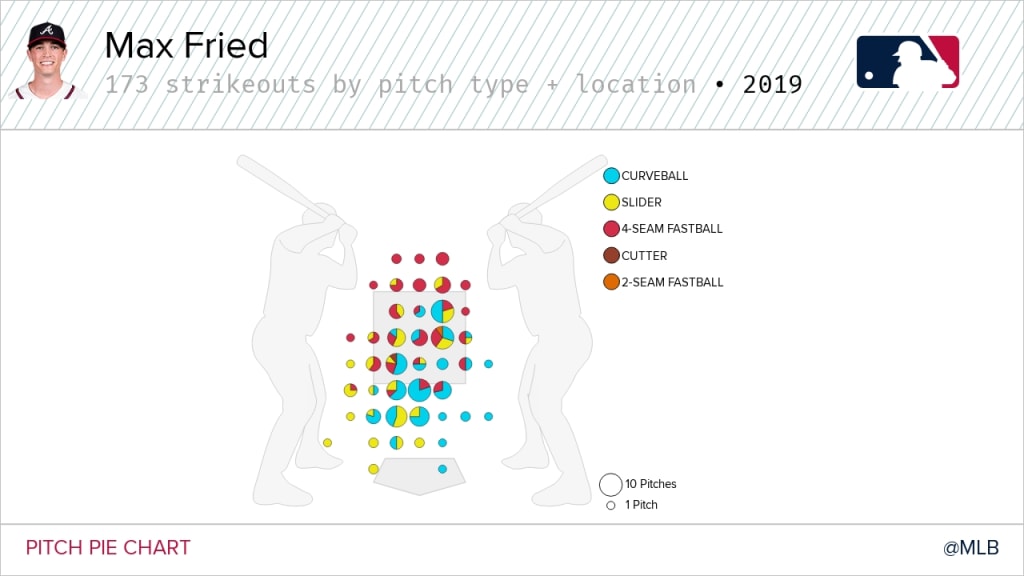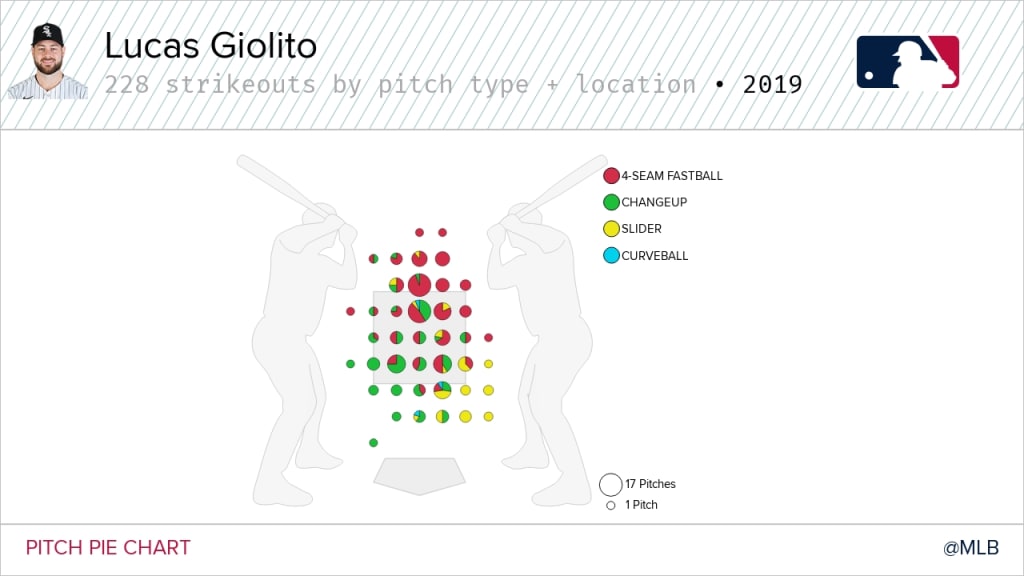It's good to be a Harvard-Westlake ballplayer.
The Los Angeles high school's star outfielder, Pete Crow-Armstrong, was just picked No. 19 overall by the Mets in the first round of the 2020 Draft. And check out the company he's joining.
A trio of Harvard-Westlake pitchers is already dominating in the Major Leagues right now. That's Jack Flaherty, Lucas Giolito and Max Fried -- three teammates at Harvard-Westlake who were all first-round Draft picks themselves and who all had breakout seasons in 2019 for their respective big league clubs, the Cardinals, White Sox and Braves.
This is what the three of them did last season:
Flaherty (age 23): 11-8, 2.75 ERA (155 ERA+), 231 K, 196 1/3 IP
Giolito (age 24): 14-9, 3.41 ERA (134 ERA+), 228 K, 176 2/3 IP
Fried (age 25): 17-6, 4.02 ERA (113 ERA+), 173 K, 165 2/3 IP
That's just, oh, a 42-23 record, 3.36 ERA and 632 strikeouts between them. Pretty good.
Flaherty finished fourth in National League Cy Young voting after a second half for the ages. His 0.91 ERA post-All-Star break was the second-best ever for a qualified starter (behind Jake Arrieta's 0.75 in 2015).
Giolito went from having the worst ERA of any qualified starter in 2018 (6.13) to ranking among the American League leaders in '19 -- he finished fifth in the AL ERA race and sixth in the AL Cy Young vote.
And Fried showed in his first full season that he has the potential of a future ace, emerging as a key young starter in a playoff-bound Braves rotation alongside Mike Soroka. Not to mention that he has one of the prettiest curveballs this side of Clayton Kershaw.
Here's how all three pitchers put their breakout 2019 seasons together, after teaming up at Harvard-Westlake.
Jack Flaherty, RHP, Cardinals
(Drafted No. 34 overall in 2014)
Arsenal
4-seam fastball -- 47% usage, 94.3 mph, 107 K
2-seam fastball -- 12% usage, 92.0 mph, 14 K
Slider -- 28% usage, 84.8 mph, 91 K
Curveball -- 12% usage, 78.2 mph, 19 K
Changeup -- 2% usage, 86.2 mph, 0 K

Key pitch: Slider
Flaherty's breaking pitches have been nasty from the beginning. That goes for both his slider and curveball, but the slider is out pitch No. 1. The 214 swings-and-misses Flaherty induced on his slider were sixth-most of any pitcher, and his 91 slider strikeouts ranked 10th. Hitters whiffed on over 45% of the Flaherty sliders they swung at, and he held them to a .184 batting average in at-bats decided by a slider.
Key stat: 86.1 mph avg. exit velocity / 30.3% hard-hit rate
Flaherty added a little velo from 2018 to '19, throwing over a mph harder. He tightened up the break on his slider and more finely located it on the low, glove-side corner (down-and-away to righties/down-and-in to lefties). And he started using his two-seamer to pepper left-handed hitters on the outside edge. Put it all together, and you get a pitcher making the leap to Cy Young contender. Flaherty held hitters to an 86.1 mph average exit velocity, 10th-best of the 152 pitchers with at least 250 batted balls against them last season. He allowed only a 30.3% hard-hit rate, eighth-best.
Max Fried, LHP, Braves
(Drafted No. 7 overall by Padres in 2012)
Arsenal
4-seam fastball -- 53% usage, 93.8 mph, 57 K
2-seam fastball -- 4% usage, 93.6 mph, 1 K
Cutter -- 0.3% usage, 93.5 mph, 1 K
Slider -- 16% usage, 83.7 mph, 46 K
Curveball -- 25% usage, 74.5 mph, 68 K
Changeup -- 2% usage, 84.8 mph, 0 K

Key pitch: Curveball
Fried throws a stunning 12-6 curveball. His curve drops 69.6 inches on average, top-five in MLB and most among lefties. That drop is nearly eight inches more than pitchers who throw their curves at similar speed and release points to Fried, giving his curve top-10 vertical movement above average. The movement comes from Fried's high spin rate -- he sat at 2,844 rpm last season, way higher than the 2,523 rpm Major League average, and he reached the elite 3,000-plus rpm spin territory 80 separate times.
Key stat: 4.4% barrel rate allowed (3.0% barrels per plate appearance)
Fried's curveball is great on its own. But it got even more effective once he added a second breaking ball, a slider, to go with it. Fried worked on the slider in Spring Training and deployed it during the 2019 season to great effect. His slider and curveball have different enough speeds but similar enough action to keep hitters off-balance. Now when hitters see a breaking ball come out of Fried's hand, they can't just wait on the big slow curve. That makes everything harder to hit … hence the great barrel rate. Fried allowed barrels -- the most dangerous kind of contact -- on just 4.4% of batted balls last season, fourth-best of that same group of 152 pitchers. Only 3% of the batters he faced barreled the ball, also fourth-best.
Lucas Giolito, RHP, White Sox
(Drafted No. 16 overall by Nationals in 2012)
Arsenal
4-seam fastball: 55% usage, 94.2 mph, 116 K
Slider: 15% usage, 84.6 mph, 37 K
Curveball: 4% usage, 79.4 mph, 3 K
Changeup: 26% usage, 81.7 mph, 72 K

Key pitch: 4-seam/changeup combo
Giolito's 180-degree turnaround from 2018 to '19 didn't hinge on just one pitch. The key was the 1-2 punch of elevated fastballs and fading changeups. Giolito totaled 188 strikeouts on those two pitches alone; the only pitcher with more was Gerrit Cole, with 191. Giolito's 365 swings-and-misses with his four-seam/changeup combination were third-most behind Cole and Luis Castillo.
Key stat: 32.3% strikeout rate
Giolito struck out nearly a third of the batters he faced. His 32.3% strikeout rate was fourth-best among qualified pitchers, and the only three guys ahead of him were Cole, Justin Verlander and Max Scherzer. If you want to cut that league-worst ERA in half, "strike everybody out" is a good way to do it. How did Giolito strike everybody out? That four-seam/changeup combo wasn't just great, it was a revamped approach. Giolito, as is the fashion these days, scrapped his two-seamer entirely to focus on the high four-seamer, a prototypical strikeout pitch. And it was heat -- Giolito gained nearly 2 mph of velocity, a huge jump, and started pumping fastballs in the high 90s with regularity. To go along with those higher, faster four-seamers, Giolito upped his changeup usage from under 16% in '18 to over 26% in '19.
Giolito, Fried and Flaherty's roads diverged from high school in Southern California to their breakout seasons in MLB. But now the Harvard-Westlake trio has arrived in one big wave. Imagine what's next.
